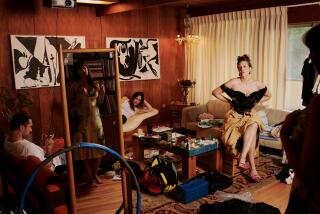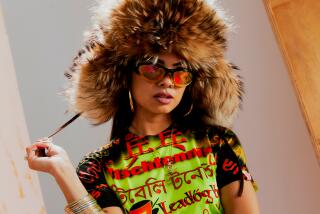Seeking a place for Eastern chic, in China
- Share via
HONG KONG — David Tang is famous for founding the Shanghai Tang label that put Mandarin-collared shirts, cheongsam dresses and other Chinese-style fashion on boutique shelves in New York and Paris.
But one of his big regrets, he says, is that the clothes aren’t more popular in China.
The 52-year-old Hong Kong fashion mogul was recently watching China’s legislature on TV, and the one thing that jumped out at him was that most of the lawmakers were wearing Western clothes, he said.
“Everyone was in a suit and tie,” he said in an interview. “That seems to me to jar the very essence of Chinese wanting to have a national identity.”
For years, Tang has tried to promote a kind of fashionable nationalism. His vehicle was Chinese fashion and lifestyle brand Shanghai Tang -- touted as the first global luxury brand to have come out of China. The brand now has 24 stores worldwide, including three in Europe, one on New York’s Madison Avenue and another in Honolulu.
The Hong Kong-based label may be gaining international recognition, but Tang says its ultimate ambition is to drive the message home -- in his own words, to “saturate the Chinese population with Chinese clothes.”
“I think it’s rather despondent that China with all its might and cleverness should not have its own sartorial elegance that it deserves,” he said.
Tang may be fiercely loyal to Chinese culture, but he doesn’t look or sound particularly Chinese.
For his interview, Tang was dressed in an untucked white shirt with tiny, bright red buttons over gray suit pants. He sported long, tousled, gray-streaked hair. He chewed on his trademark fat cigar, spoke with an arch British accent and peppered his conversation with Latin phrases such as reductio ad absurdum.
He’s a businessman with a mix of talents and interests. Apart from being a designer, a restaurateur and a Cuban cigar distributor, he’s also an avid art collector and a columnist. He was responsible for translating Roald Dahl’s “Charlie and the Chocolate Factory” into Chinese.
His next project, he says, is an Internet company so successful it will make him a billionaire. He declined to provide details.
Tang is more famously known as one of the best-connected people in Hong Kong, mingling with a vast list of rich and famous people that has included Princess Diana, Kate Moss and Fidel Castro.
How did he know all those people? “You mean how did they know me?” Tang said, laughing.
“I think my distinct advantage is being the token Chinese,” he said. “I’m able, perhaps more easily than others, to articulate what matters about being Chinese.
“I have a very strong view about most things. And I think people like to hear strong views. And therefore I tend to make a bit of an impression, probably most of the time bad ones,” he said.
In 1994 he created Shanghai Tang, an up-market store selling micro-mini Chinese dresses with sexy side slits, as well as Asian-inspired pajamas and accessories in such shades as fluorescent orange and fuchsia.
Tang also founded the exclusive China Clubs in Hong Kong, Singapore and Beijing and a high-end London restaurant called China Tang. They’re all stamped with the Tang touch -- an eclectic, retro-China-meets-Pop-Art style that has been described as “Mao-chic,” “East meets West” and, less generously, “hideous.”
Walter Ma, a Hong Kong fashion designer, said Tang’s style was too theatrical for his taste. It tries too hard to be Chinese, he said.
“I’m very annoyed by people who limit Asian design this way,” Ma said. Shanghai Tang “has its appeal, but it doesn’t mean that Chinese clothes have to be this way. It doesn’t represent Asian design at all.”
The drawing room in Tang’s massive mansion, perched atop Hong Kong’s swanky Peak area, is a showcase of his eccentric style. Walls the color of mint ice cream clash with heavy raspberry-colored curtains and decadent brocade sofas in brick red, lime and black. Every surface brims with kitschy matchboxes, miniature Greek busts and assorted bric-a-brac.
Tang maintains that his style is modernized Chinese, not East meets West.
“I think East meets West is the worst three words in modern times. It’s such a cliche,” he said.
In 1998 Tang sold the company to Swiss luxury goods group Richemont, which runs such brands as Cartier and Montblanc. Tang declined to say how much Shanghai Tang sold for, but the label now has stores worldwide and is “very profitable,” he said.
Shanghai Tang’s venture into New York, however, was a disaster, and Tang was forced to close his massive store on Madison Avenue in 1999 because of poor sales. The store was later relocated to a smaller venue on the same street.
Tang was born to a wealthy Hong Kong family. “My father did nothing, although he loved horse racing,” he said. His mother was a homemaker, he said. He was educated in Britain, where he earned a philosophy degree.
These days, he presides over his restaurants and various businesses with “an iron grip and a whip made of real leather,” he said. Tang is famous for his obsession over details, and he is impatient with people who complain about his high prices.
Critics such as Ma say Tang’s insistence that Chinese people should wear their nationalism on their sleeves is pointless. “A lot of Chinese people are accepting a more modernized style. If you’re Chinese, you don’t have to say it with loud dragons,” Ma said.
But Tang isn’t worried. China isn’t ready to embrace his message yet because many middle-class people aren’t confident enough to wear something less mainstream, he said.
The Chinese are now buying into Western brands because they crave a status symbol, he added. “But eventually, the nouveaux riches, the smarter ones.... It will come.”
Shanghai Tang’s growing presence in China appears to back his claim. Business is doubling every year and there will be as many as eight stores next year, up from the current five, said Raphael le Masne de Chermont, the brand’s executive chairman.






